4.2.5 GB/T4797.5 Classification of Environmental Conditions Natural Environmental Conditions Precipitation and Wind
This standard specifies the basic characteristics, quantitative description, and classification of precipitation and wind environmental conditions related to electrical and electronic products.
The purpose of this section is to provide background materials for selecting appropriate precipitation and wind related parameters for the severity of the product.
When selecting the appropriate severity of precipitation and wind related parameters for product applications, it is advisable to use the values given in IEC60721-1.
1. Overview
1.1) General Description
The atmosphere on Earth is constantly in motion, and local areas will be heated, cooled, and wetted. As a result, there will be gradients in density, resulting in high-pressure and low-pressure zones. Due to the Coriolis force of Earth's rotation, winds do not blow directly from high-pressure regions to low-pressure regions.
The continuous horizontal movement of air promotes slow upward movement in vast areas, or surface heating, causing local rise of hot air. The upward movement of air causes a decrease in pressure and temperature, and when both decrease sufficiently, precipitation forms. For example, at 20 ℃, the maximum water vapor content in the air is 17.3g/m3. If it drops to 0 ℃, the maximum water vapor content in the air is only 4.8g/m3.
1.2) Precipitation
The specific types of precipitation include rain, hail, or snow, all of which are the result of complex changes in cloud cover.
The formation of raindrops or ice crystals depends on various conditions, such as vertical airflow, temperature distribution, and the synthesis process of water droplets or ice crystals within clouds.
1.3) Wind
Wind refers to the lateral movement of the Earth's atmosphere from high-pressure areas to low-pressure areas.
Wind is often expressed based on its intensity and the direction in which it blows. Gusts are short-term high-speed winds. Long lasting winds have different names based on their intensity, such as breezes, strong winds, storms, hurricanes, and typhoons. There are also significant differences in the scale of wind formation: thunderstorms that last for tens of minutes, gentle winds that last for several hours caused by surface heating, and global winds caused by differences in solar energy absorption between climate zones. The two main reasons for atmospheric circulation are the difference in heat from the equator to the poles, as well as the rotation of the Earth.
2. Characteristic parameters
2.1) Rainfall
Rainfall is generally described by the following parameters:
——Rainfall intensity (accumulated rainfall height on the horizontal surface), in millimeters per hour (mm/h);
——Raindrop size distribution: typical values are 1mm~2mm in diameter, and in thunderstorms, raindrop sizes may reach 5mm~8mm;
——Distribution of landing speed: typical values are 2m/s~12m/s;
——Raindrop temperature.
Other parameters such as impurities dissolved due to air pollution and sea salt are not considered here, although these parameters may have a significant impact on the product.
Table 1 provides parameters for different types of rain.
Table 1 Characteristics of Rain (Long term Average)
降水类型 | 最大降雨强度(mm/h) |
细雨 | 0.25 |
小雨 | 1.0 |
中雨 | 4.0 |
大雨 | 16 |
暴雨 | 50 |
大暴雨 | >50 |
In general, the temperature of raindrops is the same as the wet bulb temperature ventilated on the wet surface, but there may also be deviations, such as in rain composed of ice crystals or in the early stages of rainfall.
2.2) Hail
Hail is generally described by the following parameters:
——Diameter: typical value 5mm~15mm;
——Density: Typical large hailstones will exceed 800kg/m3, while small hailstones will be less than this value;
——Landing speed;
——Impact energy;
——The typical damping coefficient (Cd) is 0.6, but the irregularity of hail size, shape, and surface roughness can affect its value.
This section only considers larger diameter hailstones as they have destructive effects, but the most common occurrence is smaller diameter hailstones.
The falling speed of hail is calculated by equation (1):
直径mm | 质量g | 降落速度m/s | 冲击能量J |
20 | 4 | 18 | 1 |
50 | 59 | 28 | 24 |
60 | 102 | 31 | 49 |
70 | 162 | 34 | 91 |
80 | 241 | 36 | 155 |
90 | 344 | 38 | 248 |
100 | 471 | 40 | 378 |
注:表中的数值是经过圆整以后的数据。 |
The following values are applied to Table 2: Cd=0.6; ρ= 900 kg/m3 (hail).
2.3) Snow
Snow is formed by water droplets freezing in the form of snow crystals. If blown by strong winds, snow crystals will break into small particles. The density range of newly fallen snow is 70 kg/m3~150 kg/m3, while the density of old snow is generally 400 kg/m3~500 kg/m3, and even up to 910 kg/m3. If the density of snow exceeds 910 kg/m3, it is considered ice. The density of solid snow is usually 600 kg/m3. Wind damage to the shape of snowflakes leads to an increase in snow density, and temperature also increases the density of snow. Due to sedimentation, the density of snow also increases.
2.4) Wind
The wind speed is greatly influenced by the local topography and altitude above the ground. The more uneven the surface, the greater the degree to which the wind speed near the ground is reduced. Therefore, the wind speed near the ground and far from the ground usually differ significantly.
3. Classification
3.1) Overview
Rain, snow, hail, and wind have different impacts on the product, individually, comprehensively, or in combination with other environmental factors.
Below are examples of individual and comprehensive parameters.
3.2) Normal rainfall
Rainfall intensity varies greatly with latitude, climate, and season. Generally speaking, the maximum rainfall intensity occurs in tropical storms and hurricane like storms.
General rainfall includes raindrops of different sizes and velocities. The characteristics of raindrops mainly depend on the temperature and moisture content of the atmosphere, which can cause some or all of the falling raindrops to vaporize. Generally speaking, at higher ground temperatures and relative humidity, the median diameter of raindrops is larger. Therefore, the diameter ratio of raindrops in tropical regions is generally larger than that in Nordic regions.
3.3) Heavy Rain
Heavy rain is a combination of wind and rain. The wind increases the speed at which raindrops fall by another level, and may also cause negative pressure on the packaging. Due to the cooling effect of low temperature rainwater, the rainfall itself will also form negative pressure.
3.4) Ice formation
3.4.1) Overview
Rainwater falling on surfaces below 0 ℃ (for example, due to radiation towards a clear night sky), or the collision of supercooled raindrops, can form ice.
3.4.2) Frost
When moist air comes into contact with surfaces below 0 ℃ and condenses, frost will form. When the wind speed is relatively low, frost often forms. Frost is composed of needle shaped crystals with relatively low surface adhesion.
3.4.3) Rime
Rime is formed by the repeated collision and freezing of supercooled water droplets carried by the wind with objects. Due to the very small and windward growth points attached to the objects, the typical appearance features a 'shrimp tail' shape, showing a white, granular structure. Rime may occur simultaneously with snow, resulting in a large area of objects being covered by snow.
3.4.4) Pure Ice
When supercooled water droplets freeze on a surface, it forms pure ice, hard, transparent or opaque, and can form a layered structure with small pores in the middle. Pure ice generally does not have a specific structure. Pure ice has a compact structure, high density, and strong adhesion. When the temperature is low and the wind speed is high, pure ice will be formed.
3.4.5) Rime
If supercooled rain falls on the surface of an object and forms a water film before freezing, it will produce rime. The density and adhesion of rime are relatively high, without bubbles.
3.4.6) Ice formation process
The type of icing mainly depends on:
——Air temperature;
——Wind speed;
——The diameter of supercooled water droplets;
——Liquid water content.
The freezing of the cylindrical surface depends on:
——Cylinder radius;
——Wind speed;
——Droplet size.
3.5) Hail
Hailstones with a diameter of less than 20mm occur in most parts of the world, while hail with a diameter exceeding 50mm has a lower probability of occurrence.
3.6) Snow load
The maximum snow load generally occurs in the southern regions during colder winters (for the northern hemisphere, the opposite is true for the southern hemisphere), especially in marine climate regions. The snow load intensity in these areas is generally 2kPa, which is equivalent to new snowfall with a height of 2m or old snow with a height of 0.7m. In mountainous areas, the intensity of snow load may reach up to 10 times.
Note: The climate conditions listed here are worldwide and are not suitable for China's national conditions.
3.7) Snow blowing
Snow blowing is a combination of wind and snow. Snow under this condition may contain very fine particles that are sufficient to penetrate the gaps and interfaces of the product. The horizontal flow of snow decreases as the height above the ground increases. Blowing snow can form on the leeward side of an object. One way to eliminate snow blowing is to establish a snow barrier. The effectiveness of a snow barrier depends on its height and distance from the protected object.
3.8) Wind force
The wind force acting on an object depends on the average wind speed, size, and shape of the object. The wind force can be calculated using equation (3):
F= 。。。。。。。。。(3)
。。。。。。。。。(3)
式中:
F——风力,单位为牛顿(N);
Cd——阻尼系数;
ρ0——大气密度,单位为千克每立方米(kg/m3);
v——平均风速,单位为米每秒(m/s);
A——物体面积,单位为平方米(m2)。
Cd由物体的形状和表面决定。例如,对于立方体来说,Cd值约为1.05,但对于电线电缆,则为1.0~1.3。
空气的密度ρ0,在标准大气压,温度为20℃时,为1.204 kg/m3。
阵风会产生短时力的冲击,在某些情况下,可能是周期性的,当与物体固有响应频率相同时,会引起大的振幅。这类阵风的频率一般低于1Hz。
一个特殊的现象是,迎风的圆柱体,由于风力的作用,后方释放出双排漩涡,它作为一种周期性的力反作用在垂直风向的圆柱上,这种现象通过Strouhal数(斯特鲁哈尔数)描述。Strouhal数是一个无量纲数,用于描述振荡流机制,是雷诺数的函数。该力的频率通过式(4)计算:
f= 。。。。。。。。。(4)
。。。。。。。。。(4)
式中:
f——频率,单位为赫兹(Hz);
St——Strouhal数,对广泛雷诺数约为0.2;
v——风速,单位为米每秒(m/s);
d——圆柱体直径,单位为米(m)。
4.2.6 GB/T4797.6 环境条件分类 自然环境条件 尘、沙、盐雾
本部分阐明自然界中出现的尘、沙、盐雾的特性,以及这些环境因素对在储存、运输和使用期间暴露其中的的影响。虽然这些环境因素的影响经成和风有密切的联系,但本部分不涉及风的环境因素,相关内容参加GB/T4797.5。
1、尘、沙、盐雾对产品的影响
1.1)尘、沙、盐雾以及相关联的风,能在各个方面对产品产生影响,最主要的是:
a)尘进入密封容器或密封体中;
b)使电气性能劣化,例如接触失效、接触电阻改变、电位器的轨道电阻变化;
c)引起轴承、轴、旋钮和其他运动部件的磨损或故障;
d)表面剥蚀(侵蚀、腐蚀);
e)导致光学表面模糊;
f)使润滑剂受污染;
g)热传导率降低;
h)导致工作的通风孔、轴衬、导管、过滤器、孔等阻塞;
i)高速运动(如沙暴)时产生静电,影响通讯系统。
1.2)尘、沙与其他环境因素(如水蒸气)的结合出现,会对产品产生严重的影响,例如发生腐蚀和长霉。湿热大气与具有化学腐蚀性的尘结合,会引起腐蚀。在大气中,盐雾也会产生类似的效果。
1.3)考虑离子传导和腐蚀性尘(例如消冰盐等)的影响。
2、自然尘与沙环境
2.1)尘和沙的分类
根据不同的空气动力学特性,尘和沙的区分如下:
——尘:可定义为无规定来源或组成的物质粒子,大小在1μm~150μm之间,由于自然的空气湍流,直径小于75μm的粒子,可在大气中旋流很长时间;
——沙:是由碎岩屑沉积物的凝离的非压实的堆积物来表示的,其基本构成为园状的石英颗粒,大小在150μm~1000μm之间。在沉积岩石学中应用本术语时,则是针对100μm~1000μm之间大小的粒子。除非是在不断地受到强的自然或诱发气流或湍流情况下,直径大于150μm的粒子是不可能停留在空中传播的。
2.2)沙尘的类型与特征
2.2.1)沙尘的类型
自然界中的大多数沙尘,主要成分是石英。在沙漠和类似的多尘地区,沙尘会使产品遭受损伤。石英的主要特点是硬度大,它能对产品,特别是运动部件,导致快速磨损或损伤。但是材料的磨蚀通常是在沙尘与高速气流或沙尘与较长作用时间周期相结合时才会发生。
2.2.2)沙尘的特性
2.2.2.1)自然尘的重要特性,是其非吸收性和化学惰性,但当大气中含有湿气或其他气体时,则可能对金属产生腐蚀作用。
2.2.2.2)细粒尘的最显著特点,通常是其非磨损性和吸湿性。
2.2.3)沙尘特征
2.2.3.1)颗粒大小
尘与沙颗粒大小的近似范围是:
——细粒尘 75μm以下;
——粗粒尘 75μm~150μm;
——沙 150μm~1000μm。
尘和沙大小的近似分布如图1所示。
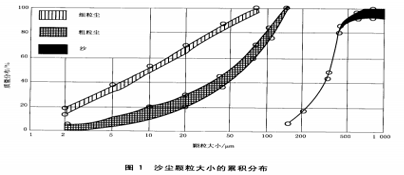
2.2.3.2)粒子硬度
单个粒子的硬度,可用来确定它对所接触物品的刮伤能力。由结晶石英微小碎渣或其他矿物质构成的沙,通常比大多数熔融硅石玻璃稍硬些。因此,沙能刮伤多数光学玻璃装置表面,在捕集的沙的粒子上施加压力可使之发生破裂。几种普通物质的硬度等级(莫氏硬度)见表1。具有较高硬度等级的物质能刮伤任何较低硬度等级的物质。
表1 几种普通物质的硬度等级
莫氏硬度等级 | 代表物质 | 典型物质 |
1 | 滑石 | 石墨 雪花石膏、硅藻土 |
2 | 石膏 | 高岭石 方铅矿石、云母,(指甲) |
3 | 方解石 | 花岗石、大理石、蛇纹石 霰石、白云石 |
4 | 氟石 | 萤石 |
5 | 磷灰石 | 石棉、蛋白石 |
6 | 正长石 | 磁铁矿石、长石 玛瑙、紫磷酸铁锰矿石、(刀具钢) |
7 | 石英 | 燧石、石英玻璃、橄榄石 红柱石、电石 |
8 | 黄晶 | 金刚砂 |
9 | 刚玉 | 蓝宝石 |
10 | 金刚石 | 钻石 |
2.2.4)浓度
2.2.4.1)根据质量可测算出浓度,即单位体积空气中粒子的质量。大气中沙尘的浓度,随着地理位置,地区气候类型与条件及人类活动程度而有较大的差异。在某些条件下,大量的沙尘是从表面的浮尘局部地和暂时地发分离出而随风飘逸。
2.2.4.2)在温和地区内,各种区域所遇到沙尘的典型浓度如表2所示。
表2 典型的沙尘浓度
地区 | 沙尘浓度mg/m3 |
乡村和市郊 | 0.04~0.11 |
城市 | 0.10~0.45 |
工业区 | 0.50~2.00 |
2.2.4.3)较高的沙尘浓度出现在诱发条件下,例如直升机和履带式车辆引起的的情况。附录A说明由直升机和车辆诱发的沙尘浓度的近似值。
2.2.4.4)沙漠上不同高度处的典型沙尘浓度,如表3所示。沙漠中近地层的沙尘在气流中的运动形式见附录B。
表3 沙漠上沙尘浓度随高度增加的变化情况
能见度条件 | 高度m | 沙尘浓度mg/m3 |
晴天,能见度130km | 150 300 600 1200 1800 | 0.21 0.22 0.17 0.14 0.055 |
沙尘暴,能见度300m 风速10m/s~15m/s | 150 300 600 900 1200 | 2.00 17.40 7.00 1.80 0.64 |
2.2.4.5)沙尘浓度及大颗粒出现的机率,随风速的增大而增加。图2说明了这种关系的一般情况,但它随诸如温度、湿度、粒子构成等因素而异。大于150μm的粒子,一般被限制在近地面1m的空气层内。在这层内约有半数沙粒(以质量计)是在地面上10mm内运动的,而另一半,大多数是在近地面上100mm内运动。
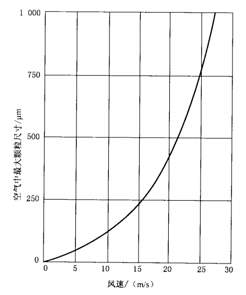
图2 沙尘最大颗粒尺寸与风速的关系图
注:本图为对最大粒子尺寸有影响的近地面条件(小于1m)的曲线
我国西北地区空气中沙尘含量(个/cm3)与风速关系的实测结果,见图3:
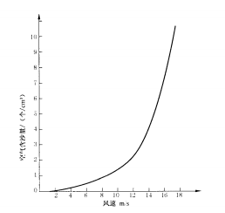
图3 户外大气中含沙量与风速的关系
注:本图为新疆火焰山戈壁滩,距地面1m高度,空气中含沙量与风速关系数据。
2.3)影响沙尘环境的因素
2.3.1)沙尘环境受诸如地形、风、温度、湿度和降水因素的影响和控制。这些因素中的任一个都不能独立的支配某地区是有尘或无尘问题,通常要有两个或更多个因素的互相结合才起作用。自然界中发生最严酷的情况,如在沙漠地区,通常所有因素对沙尘的高浓度有重要影响。地形的结构特征能够引起高速的强风,引起沙尘暴。例如,当空气强劲地通过山坳类型的地貌结构时,会显著地增大风速。
2.3.2)沙,广泛分布于地球陆地表面。表4列出了世界上主要沙漠,是自然界风吹沙尘的主要来源。世界上主要沙漠构成的面积约占陆地总面积的五分之一。所有的大陆都接壤宽度不同的沙滩,在很多内陆地区表面或接近表面有大片沙地,这些地区以前是被水覆盖。
表4 世界主要沙漠
沙漠名称 | 地理位置 | 面积 x105km2 |
撒哈拉沙漠 | 北非 | 7.8 |
澳大利亚沙漠 | 澳大利亚 | 3.4 |
阿拉伯沙漠 | 阿拉伯东南岸 | 2.6 |
土耳其斯坦沙漠 | 前苏联西南部 | 1.9 |
北美沙漠 | 美国与墨西哥 | 1.3 |
巴塔哥尼亚寒漠 | 阿根廷 | 0.7 |
塔尔沙漠 | 印度和巴基斯坦 | 0.6 |
卡拉哈利沙漠 | 南非 | 0.6 |
伊朗沙漠 | 伊朗 | 0.4 |
阿塔卡马-秘鲁沙漠 | 智利和秘鲁 | 0.4 |
塔克拉玛干沙漠 | 中国 | 0.3 |
我国主要沙漠数据见表5。我国沙漠(包括戈壁及沙漠化土地)总面积有130.8x104km2,约占我国土地总面积的13.6%。
表5 我国主要沙漠及其地理位置和面积
沙漠名称 | 地理位置 | 海拔 m | 面积 x103km2 |
塔克拉玛干沙漠 | 新疆塔里木盆地 | 840~1200 | 337.6 |
吉尔班通古特沙漠 | 新疆准噶尔盆地 | 300~600 | 48.8 |
库姆塔格沙漠 | 新疆东部、甘肃西部;罗布泊低地南部,阿尔金山北部 | 1000~1200 | 22.8 |
柴达木盆地沙漠(包括沙蚀地) | 青海柴达木盆地 | 2600~3400 | 34.9 |
巴丹吉林沙漠 | 内蒙古阿拉善高原西部 | 1300~1800 | 44.3 |
腾格里沙漠 | 内蒙古阿拉善高原东南部 | 1400~1600 | 42.7 |
乌兰布和沙漠 | 内蒙古阿拉善高原东北部,黄河河套平原西南部 | 1000 | 9.9 |
库布齐沙漠 | 内蒙古鄂尔多斯高原北部,黄河河套平原西南部 | 1000~1200 | 12.1 |
毛乌素沙地 | 内蒙古鄂尔多斯高原中南部和陕西北部 | 1300~1600 | 32.1 |
浑善达克(小腾格里)沙地 | 内蒙古高原东部的锡林郭勒盟南部和昭乌达盟西北部 | 1200 | 21.4 |
科尔沁沙地 | 东北平原西部的西辽河下游 | 100~300 | 42.3 |
呼伦贝尔沙地 | 内蒙古东北部的呼伦贝尔高平原 | 600 | 7.2 |
2.3.3)与沙相比,尘粒子有极低的沉降速度,能在空气中长久维持悬浮状态,并可停留于任何所处的表面。在干燥条件下,含尘量(以质量计)9%以上的土壤会变成至少中等粉末状,含尘量大于14%以上的土壤可能完全灰尘状。除南极外,世界陆地面积的40%为干旱地区,而另有40%是属于季节性干燥地区,因此,一年中大部分时间,世界陆地表面的大部分地区,预期会出现尘。
甚至在有大雨的区域,如果那里的保护覆被被破坏,尘也会产生。许多潮湿地区有很好的排水,以致大部分无保护的土壤在大雨后非常短的时间内会变成尘。
2.3.4)图4描述了在中等强度内陆风地区,风的出现情况。图5描述了我国西北地区起沙风(风速≥5m/s)的出现次数与风速频率的关系。
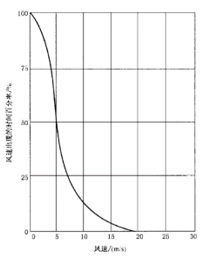
图4 在中等强度风的内陆地区风的出现情况
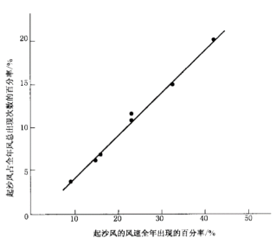
图5 起沙风的出现次数与风速频率的关系
注:本图为新疆塔克拉玛干地区起沙风与风速的关系。
2.3.5)图6描述了不同大小粒子的沉降速度。从该图可估计沉降时间,对小粒子应考虑热变化和其他气流对沉降时间的影响。
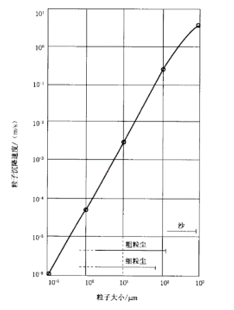
图6 静态空气中粒子的沉降速度
注:曲线为温度0℃,大气压力为101.3kPa时,浓度为1g/cm3的粒子的情况。
3、百叶箱和封闭场中的沙尘
3.1)沙尘特征
3.1.1)尘的特征
在百叶箱和封闭场所,可发现各种物质的尘,如石英、水泥、粉状物、有机纤维等。
3.1.2)颗粒大小的分布
颗粒大小的分布,按是否户外、装卸车辆或百叶箱场所来考虑而有显著的差异。由于掩护物的过滤作用,在百叶箱和封闭场所中的最大粒子尺寸,要比无气候防护场所的小些。在百叶箱和封闭场所中最大粒子尺寸约为100μm。
3.1.3)尘的沉积密度
在不同地区沙尘沉积密度的典型值见表6。沙尘沉积量值是从户外大气流入测量器中沙尘的样品,不可拿它们来考虑封闭场所中的局部尘,例如,在矿山、水泥厂、锯木厂和类似场所中,在那里沉积的发生遍及整个生产过程。
表6 典型的沙尘沉降密度
地区 | 沙尘沉积量 mg/m2*h |
乡村和郊区 | 0.4~15 |
城市 | 15~40 |
工业区 | 40~80 |
3.2)影响沙尘环境的因素
3.2.1)地区和场所
3.2.1.1)在百叶箱或封闭场所中,沙尘产生的影响与户外场所,例如在沙漠地区出现的尘暴,尘土路上行驶车辆周围的局部环境等,有显著的差异。
3.2.1.2)在百叶箱和封闭场所出现的沙尘,是由多种来源引起的,沙尘可能是石英、消冰盐、肥料等,它们可通过通风孔或损坏的窗户侵入这样的场所。
3.2.1.3)尘也可能是天然的小纤维或人造材料组成的,例如,从起居室或办公室日常使用的衣服或地毯产生的。
3.2.1.4)其他的尘缘(例如种子)会在仓库里或面粉作坊里出现。
3.2.1.5)物质颗粒大小的分布,随不同类型的尘而异。唯一共同点是,它们具有的最大粒子尺寸是近似一致的。
3.2.2)尘的影响
在百叶箱或封闭场所,也有微小的空气运动,识别这种气流作用的依据是:
a)沉积:产品上沙尘的沉积,可能由四种不同的机理引起:
1)在停滞空气中的沉积;
2)在被保护表面上的沉积;
3)静电力的吸引;
4)用狭孔通道捕集,例如在有强迫空气循环的过滤器中。
空气运动有延缓或阻碍沙尘沉积的倾向。
b)侵入:沙尘侵入产品内的过程可能是这样发生的:
1)由强迫空气循环带入内部;
2)由空气的热运动带入内部;
3)由空气的热膨胀和凝缩或大气压力的变化,进入内部。